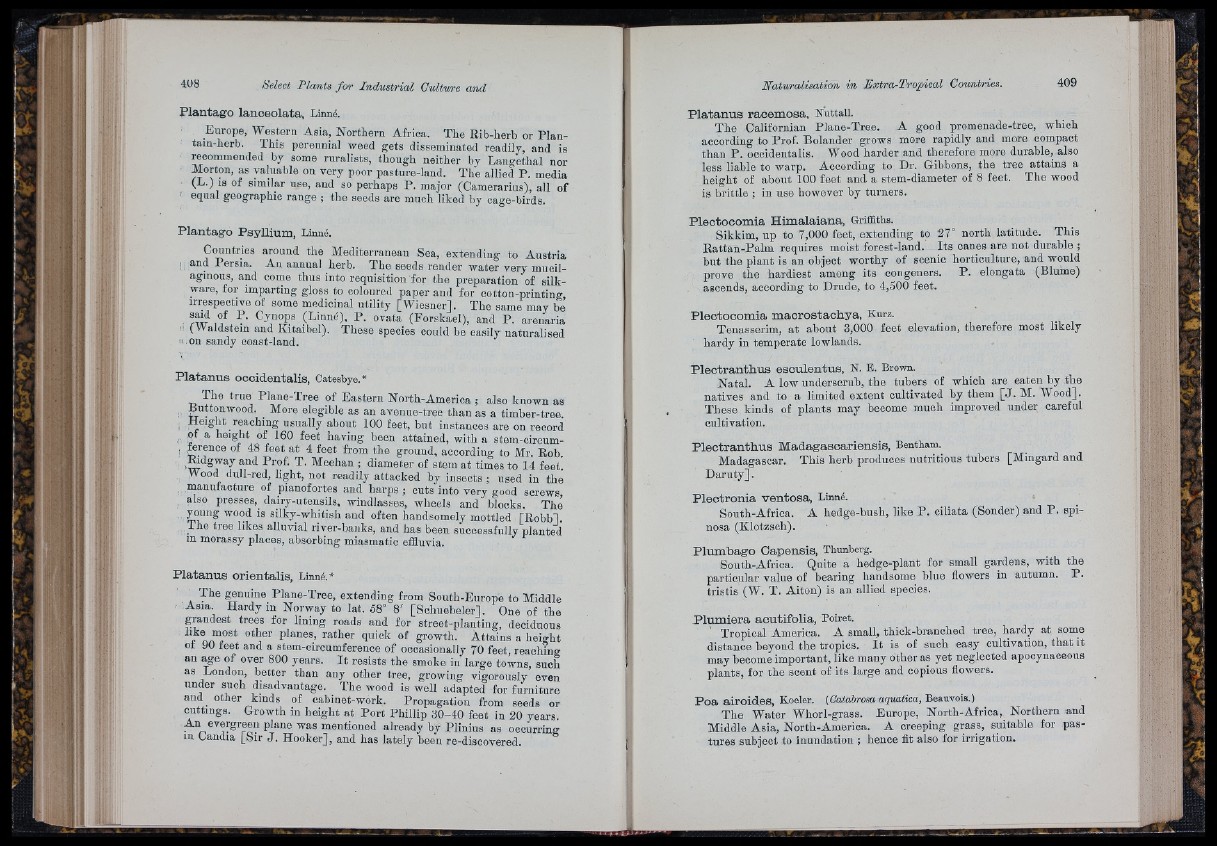
‘fi: !
Il- )
-H:
P la n ta d o la n c e o la ta , Linné.
Europe, Western Asia, Northern Africa. The Rib-herb or Plan-
taiu-herb. This perennial weed gets disseminated readily, and is
recommended by some ruralists, though neither by Langethal nor
Morton, as valuable on very poor pasture-land. The allied P . media
(L.) IS of similar use, and so perhaps P. major (Camerarius), all of
■ equal geographic range ; the seeds are much liked by cage-birds.
P la n ta g o P sy llium , Linné.
Countries around the Mediterranean Sea, extending to Austria
I and Persia. An annual herb. The seeds render water very mucilaginous,
and come thus into requisition for the preparation of silk-
ware, for imparting gloss to coloured paper aud for cotton-printing,
irrespective of some medicinal utility [Wiesner]. The same may be
said of P. Cynops (Linné), P. ovata (Forskael), and P. arenaria
: (Waldstem and Kitaibel). These species could be easily naturalised
I on sandy coast-Iand.
P la ta n u s o c c id e n ta lis, Catesbye.*
The true Plane-Tree of Eastern North-America ; also known as
Buttonwood. _ More elegible as an avenue-tree than as a timber-tree.
Height reaching usually about 100 feet, bnt instances are on record
of a height of 160 feet having been attained, with a stem-circum-
^forence of 48 feet a t 4 feet from the ground, according to Mr. Rob.
ILdgway and Prof. T. Meehan ; diameter of stem a t times to 14 feet.
Wood dull-red, light, not readily attacked by insects ; nsed in the
manufacture of pianofortes and harps ; cuts into very good screws,
also presses, dairy-utensils, windlasses, wheels and blocks. The
young wood is silky-whitish and often handsomely mottled [Robb].
The tree likes alluvial river-banks, and has been successfully planted
in morassy places, absorbing miasmatic effluvia.
P la ta n u s o rie n ta lis , Linné.*
The genuine Plane-Tree, extending from South-Europe to Middle
Asia Hardy in Norway to lat. 58“ 8' [Schuebeler]. One of the
grandest trees for lining roads and for street-planting, deciduous
f ‘■‘‘tFer quick of growth. Attains a height
ot 90 feet and a stem-circumference of occasionally 70 feet, reaching
an age of over 800 years. I t resists the smoke iu large towns, such
as London, better tban any other tree, growing vigorously even
under such disadvantage. The wood is well adapted for furniture
and other kinds of cabinet-work. Propagation from seeds or
cuttings. Growth in height at Port Phillip 30-40 feet in 20 years.
An evergreen plane was mentioned already by Plinius as occurring
in Oandia [Sir J . Hooker], and has lately been re-discovered.
P la t a n u s ra c em o s a , Nuttall.
The Californian Plane-Tree. A good promenade-tree, which
according to Prof. Bolander grows more rapidly and more compact
than P . occidentalis. Wood harder and therefore more durable, also
less liable to warp. According to Dr. Gibbons, the tree attains a
height of about 100 feet and a stem-diameter of 8 feet. The wood
is brittle ; in use however by turners.
P le o to c om ia H im a la ia n a , Griffiths.
Sikkim, up to 7,000 feet, extending to 27° north latitude. This
Rattan-Palm requires moist forest-land. Its canes are not durable ;
but the plant is an object worthy of scenic horticulture, and would
prove the hardiest among its congeners. P. elongata (Blume)
ascends, according to Drude, to 4,500 feet.
P le c to c om ia m a c ro s ta c h y a , Kurz.
Tenasserim, a t about 3,000 feet elevation, therefore most likely
hardy in temperate lowlands.
P le c t r a n th u s e s c u le n tu s , N. E. Brown.
Natal. A low uuderscriib, the tubers of which are eaten by the
natives and to a limited extent cultivated by them [ J . M. Wood].
These kinds of plants may become much improved under careful
cultivation.
P le c t r a n th u s M a d a g a s c a rie n s is , Bentham.
Madagascar. This herb produces nutritious tubers [Mingard and
Dariity].
P le c tro n ia v e n to s a , Linné.
South-Africa. A hedge-bush, like P . ciliata (Sonder) and P. spinosa
(Klotzsch).
P lum b a g o C ap en sis , Thunberg.
South-Africa. Quite a hedge-plant for small gardens, with the
particular value of bearing handsome blue flowers iu autumn. P .
tristis (W. T. Aiton) is an allied species.
P lum ie r a a c u tifo lia , Poiret.
' Tropical America. A small, thick-branched tree, hardy at some
distance beyond the tropics. I t is of such easy cultivation, th a t it
may become important, like many other as yet neglected apocynaceous
plants, for the scent of its large and copious flowers.
P o a a iro id e s , Koeler. (Gatabrosa aquatica, Beauvois.)
The Water Whorl-grass. Europe, North-Africa, Northern and
Middle Asia, North-America. A creeping grass, suitable for pastures
subject to inundation ; hence fit also for irrigation.
j h i
c ' i
, . 'br
■V1 :Sr